maintenance TOYOTA YARIS 2013 Owners Manual
[x] Cancel search | Manufacturer: TOYOTA, Model Year: 2013, Model line: YARIS, Model: TOYOTA YARIS 2013Pages: 712, PDF Size: 30.2 MB
Page 1 of 712
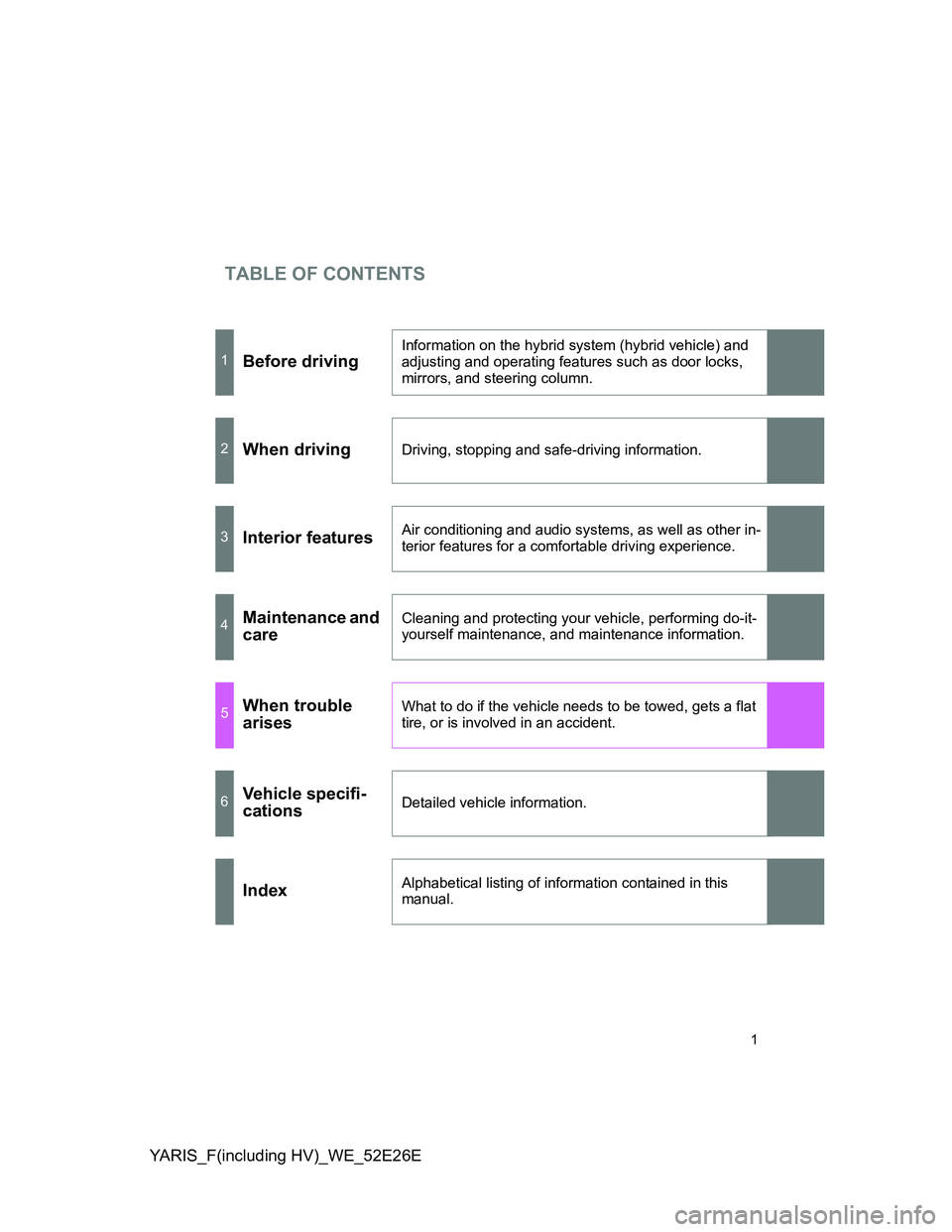
TABLE OF CONTENTS
YARIS_F(including HV)_WE_52E26E
1
1Before driving
Information on the hybrid system (hybrid vehicle) and
adjusting and operating features such as door locks,
mirrors, and steering column.
2When drivingDriving, stopping and safe-driving information.
3Interior featuresAir conditioning and audio systems, as well as other in-
terior features for a comfortable driving experience.
4Maintenance and
careCleaning and protecting your vehicle, performing do-it-
yourself maintenance, and maintenance information.
5When trouble
arisesWhat to do if the vehicle needs to be towed, gets a flat
tire, or is involved in an accident.
6Vehicle specifi-
cationsDetailed vehicle information.
IndexAlphabetical listing of information contained in this
manual.
Page 5 of 712
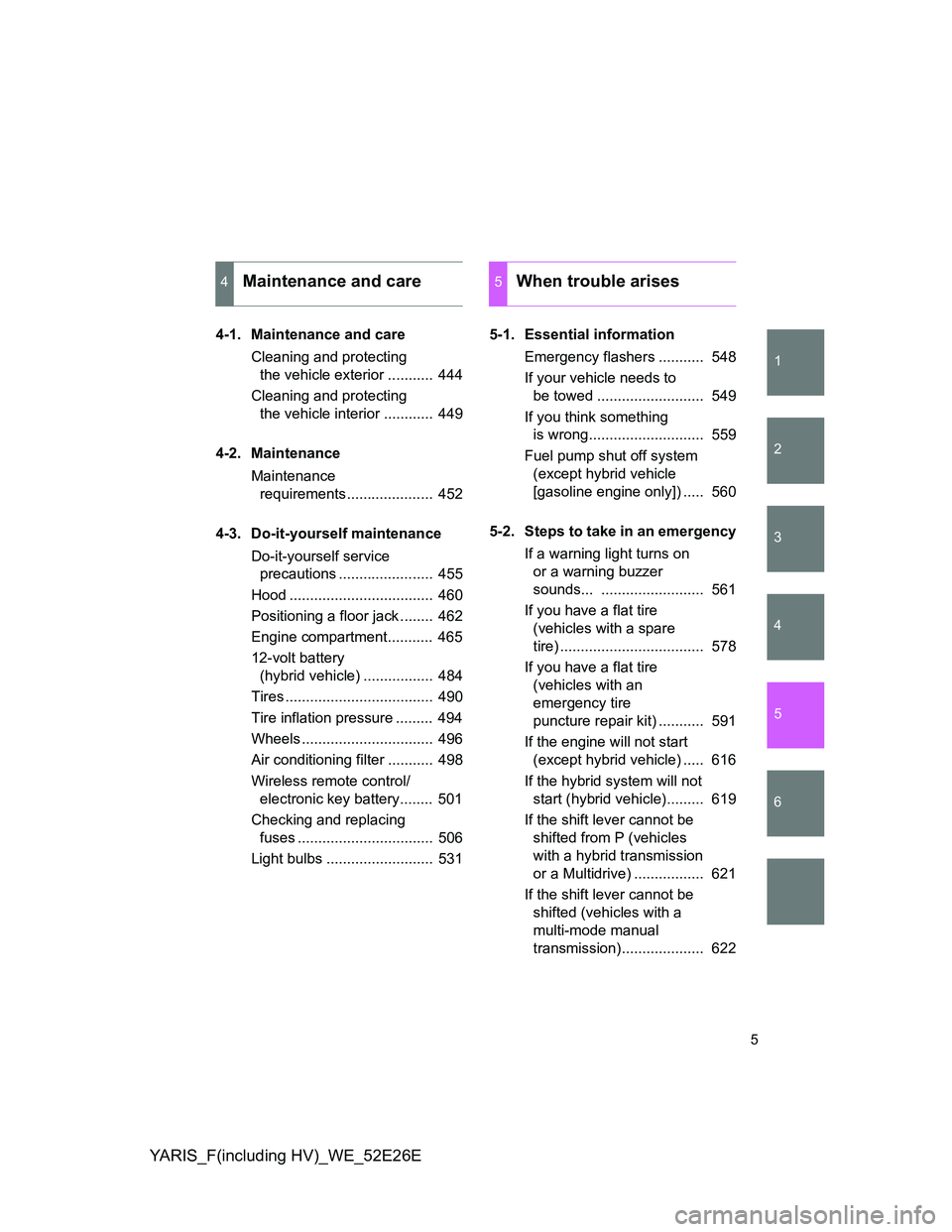
1
2
3
4
5
6
YARIS_F(including HV)_WE_52E26E
5
4-1. Maintenance and care
Cleaning and protecting
the vehicle exterior ........... 444
Cleaning and protecting
the vehicle interior ............ 449
4-2. Maintenance
Maintenance
requirements..................... 452
4-3. Do-it-yourself maintenance
Do-it-yourself service
precautions ....................... 455
Hood ................................... 460
Positioning a floor jack ........ 462
Engine compartment........... 465
12-volt battery
(hybrid vehicle) ................. 484
Tires .................................... 490
Tire inflation pressure ......... 494
Wheels ................................ 496
Air conditioning filter ........... 498
Wireless remote control/
electronic key battery........ 501
Checking and replacing
fuses ................................. 506
Light bulbs .......................... 5315-1. Essential information
Emergency flashers ........... 548
If your vehicle needs to
be towed .......................... 549
If you think something
is wrong............................ 559
Fuel pump shut off system
(except hybrid vehicle
[gasoline engine only]) ..... 560
5-2. Steps to take in an emergency
If a warning light turns on
or a warning buzzer
sounds... ......................... 561
If you have a flat tire
(vehicles with a spare
tire) ................................... 578
If you have a flat tire
(vehicles with an
emergency tire
puncture repair kit) ........... 591
If the engine will not start
(except hybrid vehicle) ..... 616
If the hybrid system will not
start (hybrid vehicle)......... 619
If the shift lever cannot be
shifted from P (vehicles
with a hybrid transmission
or a Multidrive) ................. 621
If the shift lever cannot be
shifted (vehicles with a
multi-mode manual
transmission).................... 622
4Maintenance and care5When trouble arises
Page 6 of 712
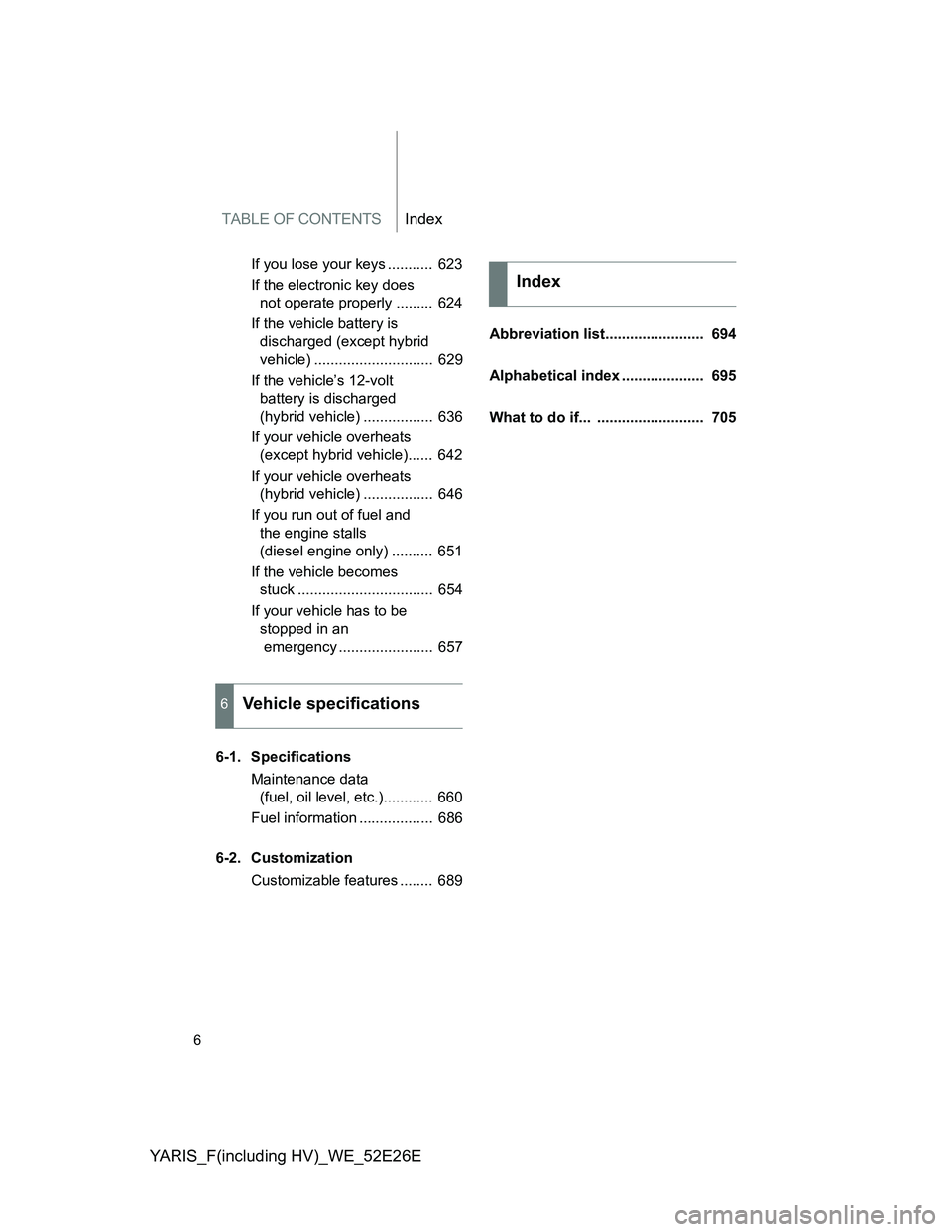
TABLE OF CONTENTSIndex
YARIS_F(including HV)_WE_52E26E
6
If you lose your keys ........... 623
If the electronic key does
not operate properly ......... 624
If the vehicle battery is
discharged (except hybrid
vehicle) ............................. 629
If the vehicle’s 12-volt
battery is discharged
(hybrid vehicle) ................. 636
If your vehicle overheats
(except hybrid vehicle)...... 642
If your vehicle overheats
(hybrid vehicle) ................. 646
If you run out of fuel and
the engine stalls
(diesel engine only) .......... 651
If the vehicle becomes
stuck ................................. 654
If your vehicle has to be
stopped in an
emergency ....................... 657
6-1. Specifications
Maintenance data
(fuel, oil level, etc.)............ 660
Fuel information .................. 686
6-2. Customization
Customizable features ........ 689Abbreviation list........................ 694
Alphabetical index .................... 695
What to do if... .......................... 705
6Vehicle specifications
Index
Page 51 of 712
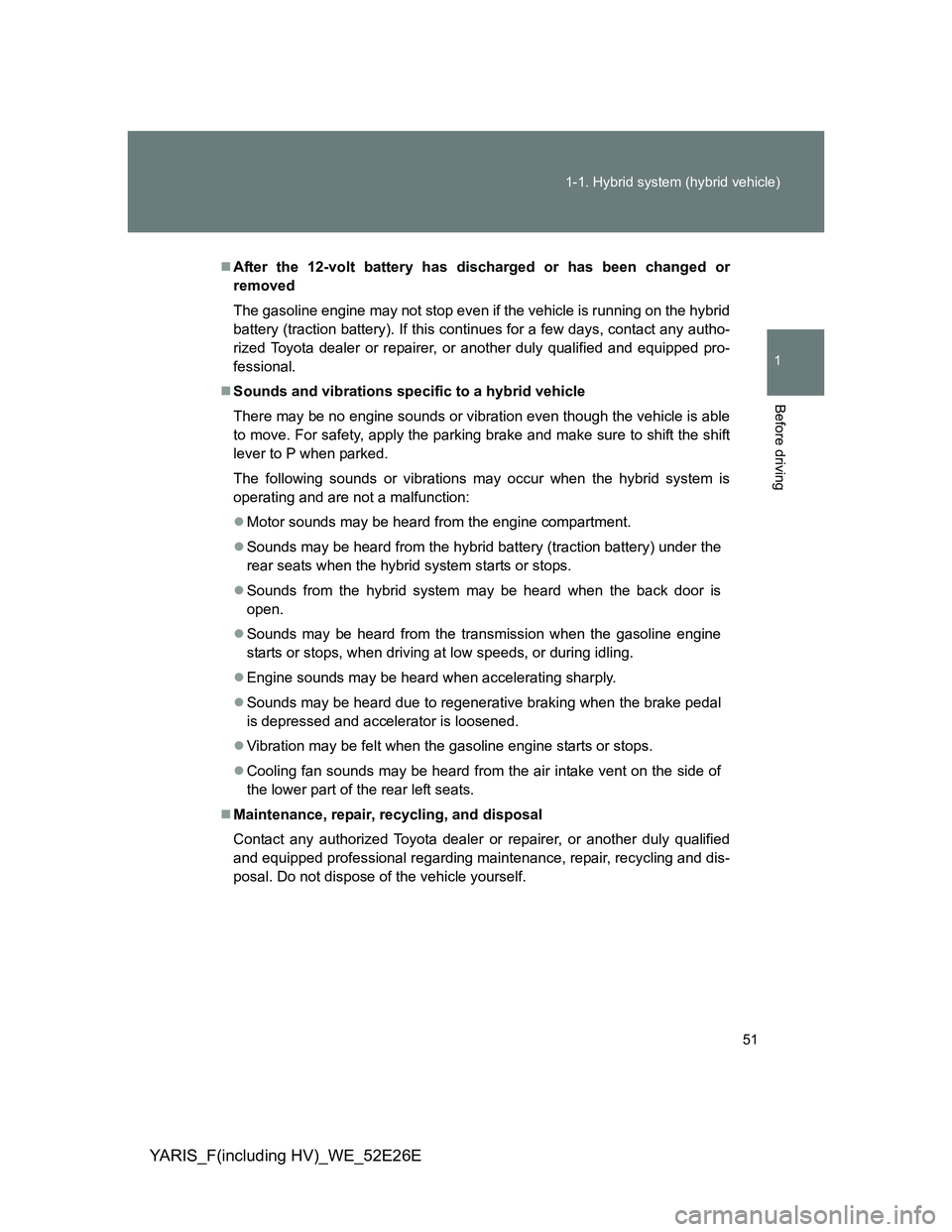
51 1-1. Hybrid system (hybrid vehicle)
1
Before driving
YARIS_F(including HV)_WE_52E26E
After the 12-volt battery has discharged or has been changed or
removed
The gasoline engine may not stop even if the vehicle is running on the hybrid
battery (traction battery). If this continues for a few days, contact any autho-
rized Toyota dealer or repairer, or another duly qualified and equipped pro-
fessional.
Sounds and vibrations specific to a hybrid vehicle
There may be no engine sounds or vibration even though the vehicle is able
to move. For safety, apply the parking brake and make sure to shift the shift
lever to P when parked.
The following sounds or vibrations may occur when the hybrid system is
operating and are not a malfunction:
Motor sounds may be heard from the engine compartment.
Sounds may be heard from the hybrid battery (traction battery) under the
rear seats when the hybrid system starts or stops.
Sounds from the hybrid system may be heard when the back door is
open.
Sounds may be heard from the transmission when the gasoline engine
starts or stops, when driving at low speeds, or during idling.
Engine sounds may be heard when accelerating sharply.
Sounds may be heard due to regenerative braking when the brake pedal
is depressed and accelerator is loosened.
Vibration may be felt when the gasoline engine starts or stops.
Cooling fan sounds may be heard from the air intake vent on the side of
the lower part of the rear left seats.
Maintenance, repair, recycling, and disposal
Contact any authorized Toyota dealer or repairer, or another duly qualified
and equipped professional regarding maintenance, repair, recycling and dis-
posal. Do not dispose of the vehicle yourself.
Page 156 of 712
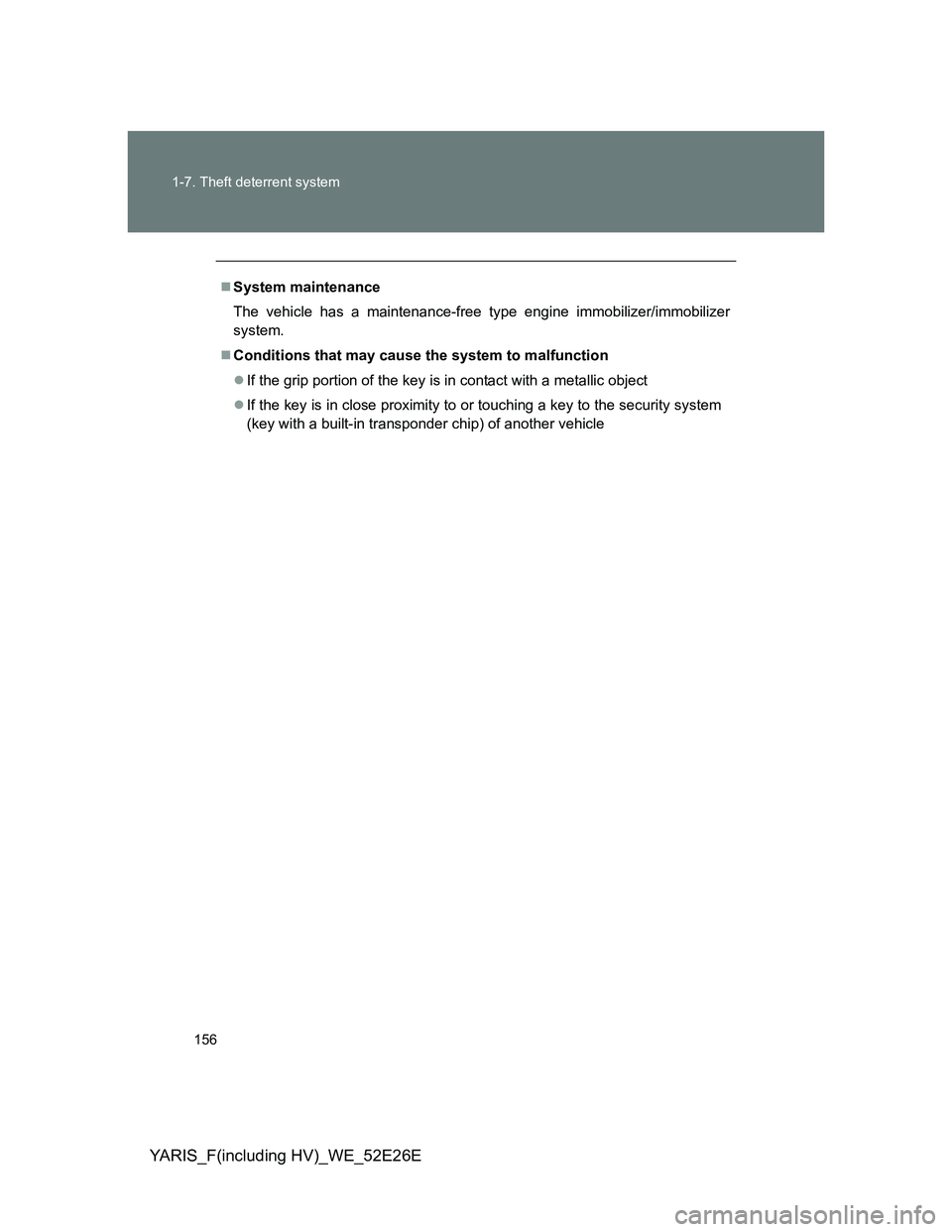
156 1-7. Theft deterrent system
YARIS_F(including HV)_WE_52E26E
System maintenance
The vehicle has a maintenance-free type engine immobilizer/immobilizer
system.
Conditions that may cause the system to malfunction
If the grip portion of the key is in contact with a metallic object
If the key is in close proximity to or touching a key to the security system
(key with a built-in transponder chip) of another vehicle
Page 347 of 712
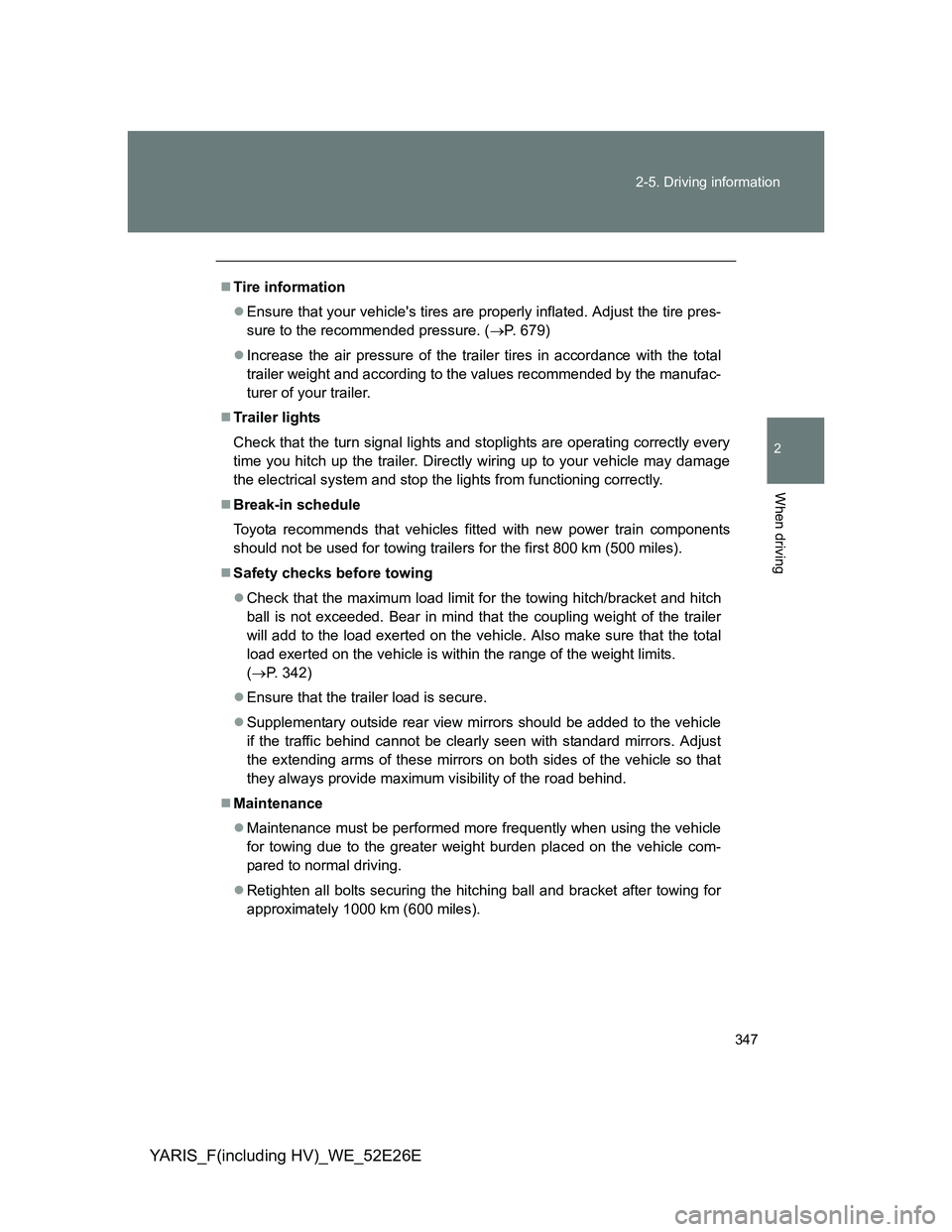
347 2-5. Driving information
2
When driving
YARIS_F(including HV)_WE_52E26E
Tire information
Ensure that your vehicle's tires are properly inflated. Adjust the tire pres-
sure to the recommended pressure. (P. 679)
Increase the air pressure of the trailer tires in accordance with the total
trailer weight and according to the values recommended by the manufac-
turer of your trailer.
Trailer lights
Check that the turn signal lights and stoplights are operating correctly every
time you hitch up the trailer. Directly wiring up to your vehicle may damage
the electrical system and stop the lights from functioning correctly.
Break-in schedule
Toyota recommends that vehicles fitted with new power train components
should not be used for towing trailers for the first 800 km (500 miles).
Safety checks before towing
Check that the maximum load limit for the towing hitch/bracket and hitch
ball is not exceeded. Bear in mind that the coupling weight of the trailer
will add to the load exerted on the vehicle. Also make sure that the total
load exerted on the vehicle is within the range of the weight limits.
(P. 342)
Ensure that the trailer load is secure.
Supplementary outside rear view mirrors should be added to the vehicle
if the traffic behind cannot be clearly seen with standard mirrors. Adjust
the extending arms of these mirrors on both sides of the vehicle so that
they always provide maximum visibility of the road behind.
Maintenance
Maintenance must be performed more frequently when using the vehicle
for towing due to the greater weight burden placed on the vehicle com-
pared to normal driving.
Retighten all bolts securing the hitching ball and bracket after towing for
approximately 1000 km (600 miles).
Page 443 of 712
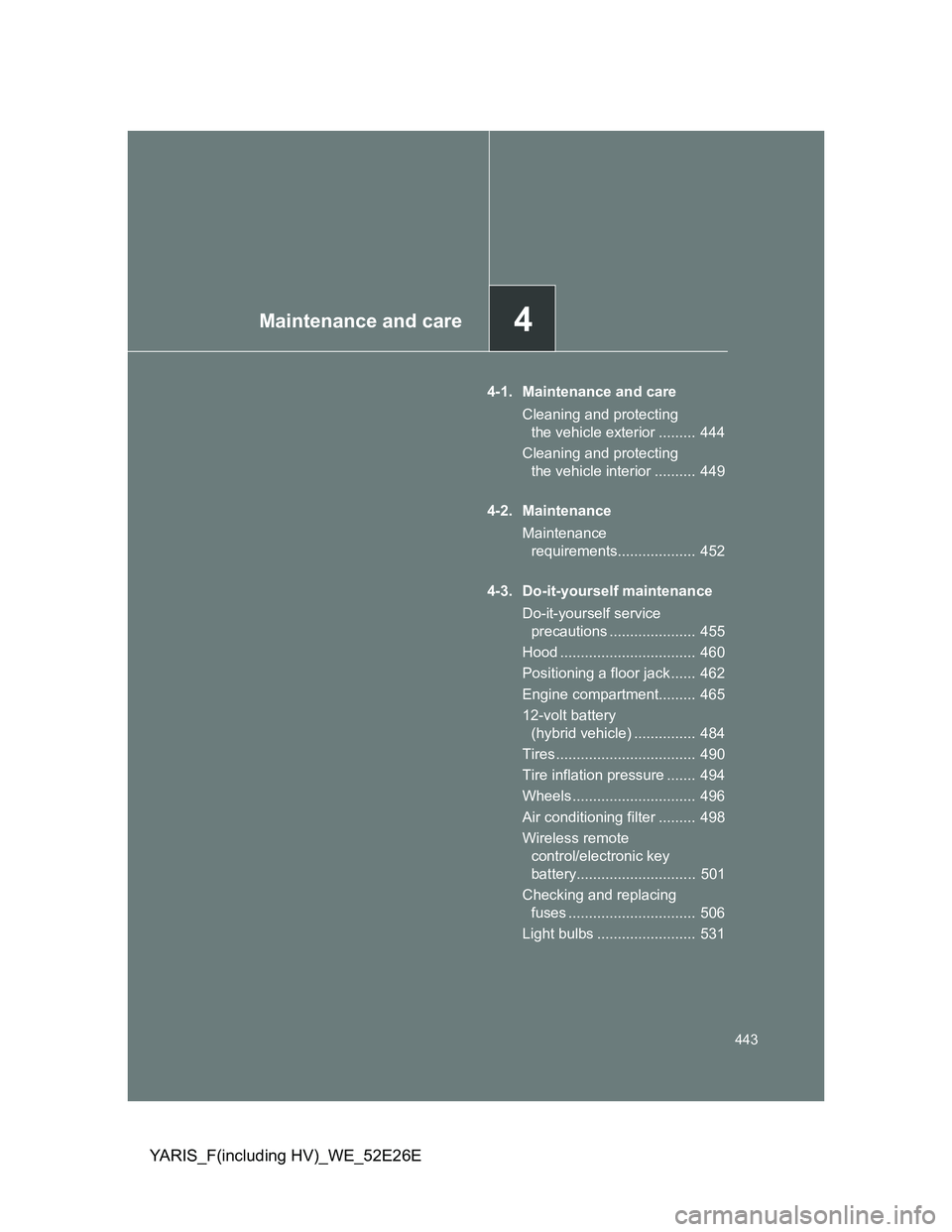
4Maintenance and care
443
YARIS_F(including HV)_WE_52E26E
4-1. Maintenance and care
Cleaning and protecting
the vehicle exterior ......... 444
Cleaning and protecting
the vehicle interior .......... 449
4-2. Maintenance
Maintenance
requirements................... 452
4-3. Do-it-yourself maintenance
Do-it-yourself service
precautions ..................... 455
Hood ................................. 460
Positioning a floor jack ...... 462
Engine compartment......... 465
12-volt battery
(hybrid vehicle) ............... 484
Tires .................................. 490
Tire inflation pressure ....... 494
Wheels .............................. 496
Air conditioning filter ......... 498
Wireless remote
control/electronic key
battery............................. 501
Checking and replacing
fuses ............................... 506
Light bulbs ........................ 531
Page 444 of 712
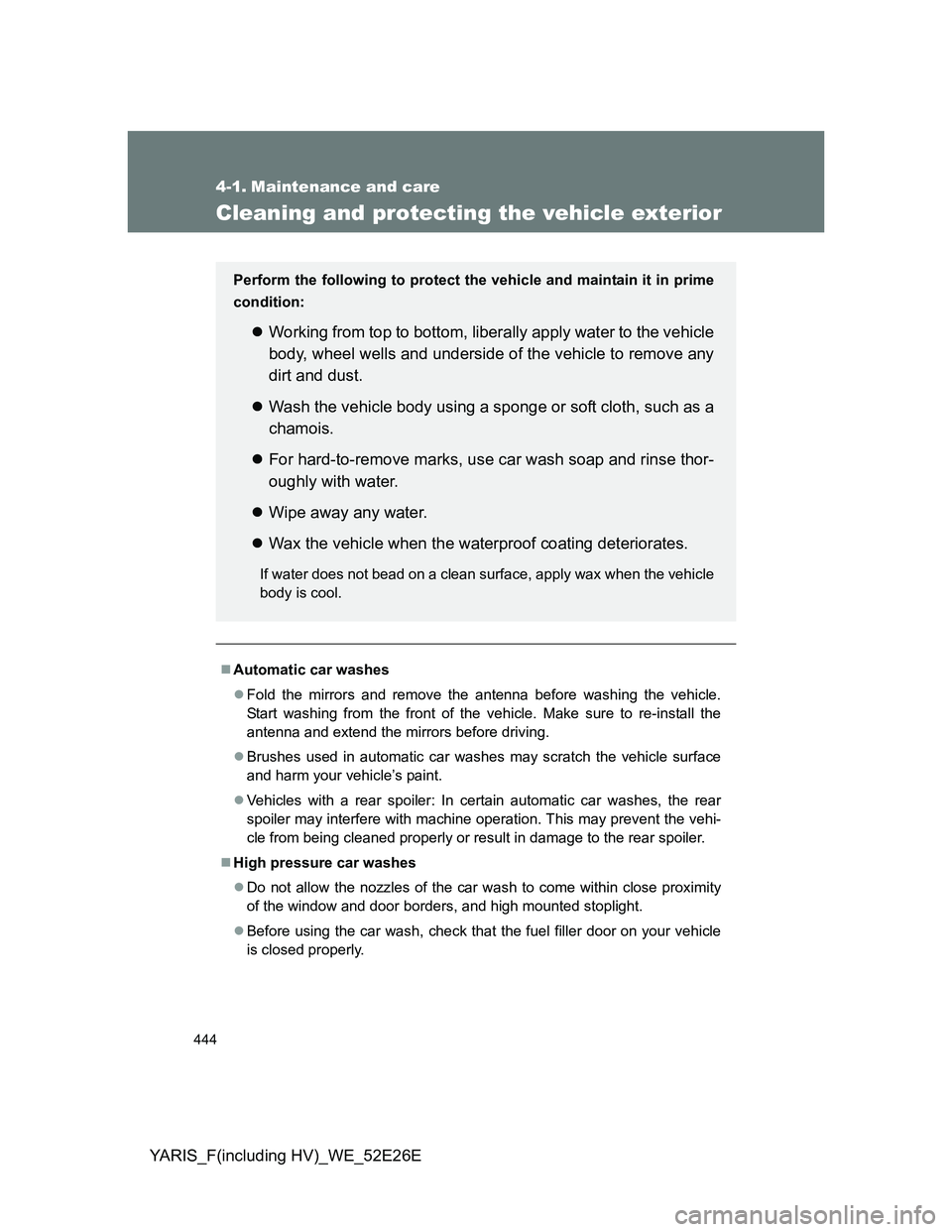
444
YARIS_F(including HV)_WE_52E26E
4-1. Maintenance and care
Cleaning and protecting the vehicle exterior
Automatic car washes
Fold the mirrors and remove the antenna before washing the vehicle.
Start washing from the front of the vehicle. Make sure to re-install the
antenna and extend the mirrors before driving.
Brushes used in automatic car washes may scratch the vehicle surface
and harm your vehicle’s paint.
Vehicles with a rear spoiler: In certain automatic car washes, the rear
spoiler may interfere with machine operation. This may prevent the vehi-
cle from being cleaned properly or result in damage to the rear spoiler.
High pressure car washes
Do not allow the nozzles of the car wash to come within close proximity
of the window and door borders, and high mounted stoplight.
Before using the car wash, check that the fuel filler door on your vehicle
is closed properly.
Perform the following to protect the vehicle and maintain it in prime
condition:
Working from top to bottom, liberally apply water to the vehicle
body, wheel wells and underside of the vehicle to remove any
dirt and dust.
Wash the vehicle body using a sponge or soft cloth, such as a
chamois.
For hard-to-remove marks, use car wash soap and rinse thor-
oughly with water.
Wipe away any water.
Wax the vehicle when the waterproof coating deteriorates.
If water does not bead on a clean surface, apply wax when the vehicle
body is cool.
Page 445 of 712
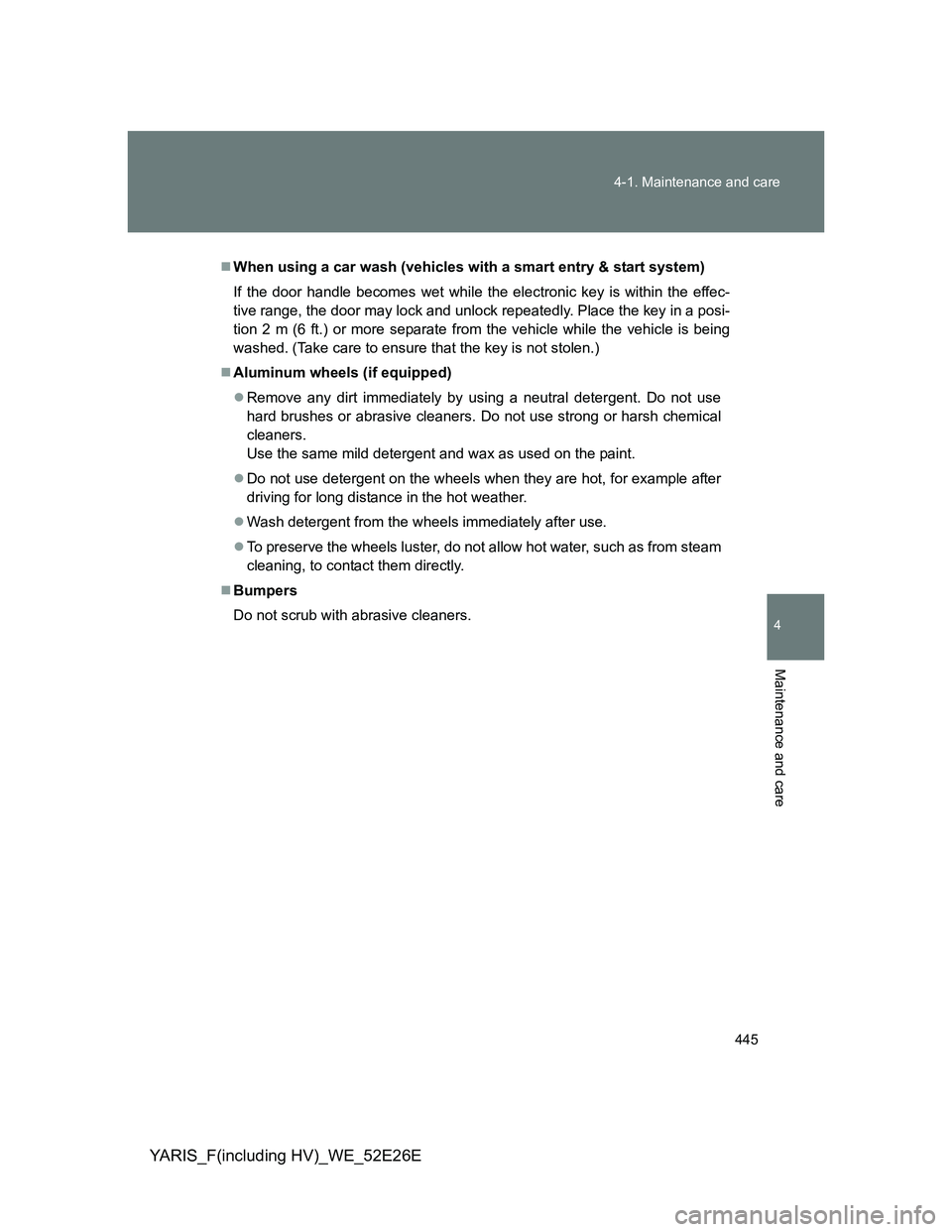
445 4-1. Maintenance and care
4
Maintenance and care
YARIS_F(including HV)_WE_52E26E
When using a car wash (vehicles with a smart entry & start system)
If the door handle becomes wet while the electronic key is within the effec-
tive range, the door may lock and unlock repeatedly. Place the key in a posi-
tion 2 m (6 ft.) or more separate from the vehicle while the vehicle is being
washed. (Take care to ensure that the key is not stolen.)
Aluminum wheels (if equipped)
Remove any dirt immediately by using a neutral detergent. Do not use
hard brushes or abrasive cleaners. Do not use strong or harsh chemical
cleaners.
Use the same mild detergent and wax as used on the paint.
Do not use detergent on the wheels when they are hot, for example after
driving for long distance in the hot weather.
Wash detergent from the wheels immediately after use.
To preserve the wheels luster, do not allow hot water, such as from steam
cleaning, to contact them directly.
Bumpers
Do not scrub with abrasive cleaners.
Page 446 of 712
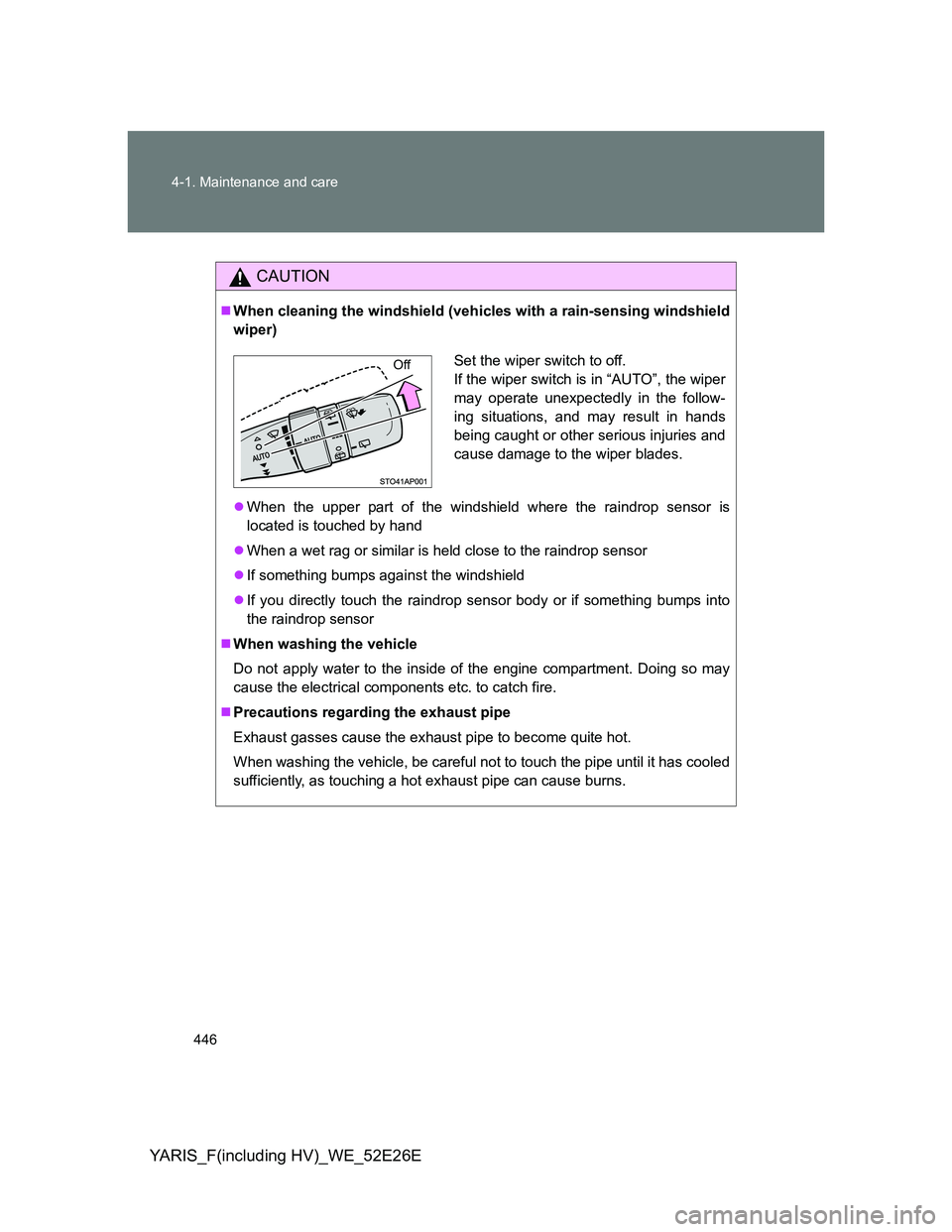
446 4-1. Maintenance and care
YARIS_F(including HV)_WE_52E26E
CAUTION
When cleaning the windshield (vehicles with a rain-sensing windshield
wiper)
When the upper part of the windshield where the raindrop sensor is
located is touched by hand
When a wet rag or similar is held close to the raindrop sensor
If something bumps against the windshield
If you directly touch the raindrop sensor body or if something bumps into
the raindrop sensor
When washing the vehicle
Do not apply water to the inside of the engine compartment. Doing so may
cause the electrical components etc. to catch fire.
Precautions regarding the exhaust pipe
Exhaust gasses cause the exhaust pipe to become quite hot.
When washing the vehicle, be careful not to touch the pipe until it has cooled
sufficiently, as touching a hot exhaust pipe can cause burns.
Set the wiper switch to off.
If the wiper switch is in “AUTO”, the wiper
may operate unexpectedly in the follow-
ing situations, and may result in hands
being caught or other serious injuries and
cause damage to the wiper blades.Off